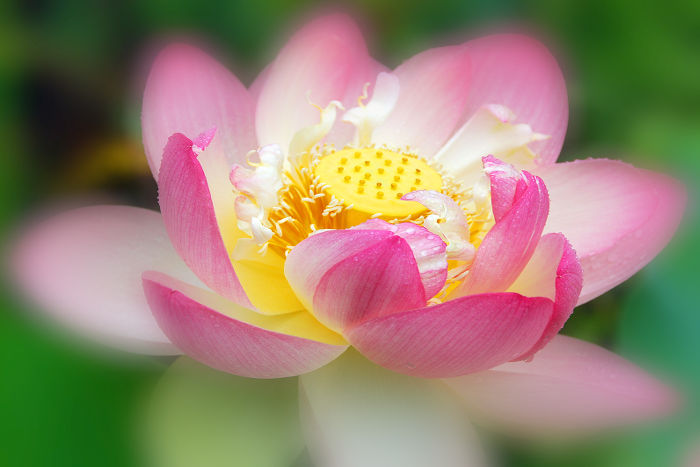LOTUS Flowers
Flowers often pick up religious and spiritual meanings because they rise from dirt and only show their beauty for a brief amount of time each year. The Lotus Flower is no different from the rest of the blooms used for decorating and religious ceremonies. Few flowers are as important to Eastern cultures as the Lotus, and each culture ascribes a slightly different meaning to the flower. Dive into the depths of the Lotus blossom meaning by looking at every aspect of this fascinating plant
The Lotus is a delicate flower with many layered petals arrayed around a central core. A few different plants from separate families all make up this category, but they all have similar meanings when it comes to symbolism. The plants also look alike and share other characteristics like medicinal and edible value. In general, all the Lotus flowers exude beauty and grace. Most varieties grow in the water of ponds and creeks, lending them an otherworldly quality that makes them mystical enough for religious ceremonies. In the Victorian flower language, the Lotus represented eloquence.
- The Egyptian lotus flower: With the scientific name of Nymphaea caerula, the Egyptian blue lotus is actually more accurately described as a water lily. These blooms sport light blue or purple petals and played an important role in spiritual events.
- The Japanese lotus flower: Also known as the sacred Lotus in China, Bali, and other tropical countries in Asia, this plant’s scientific name is Nelumbo nucifera. It is the flower you see being used as the seat of Buddha and many Hindu deities too.
- The American lotus flower: A bright yellow Lotus, the Nelumbo lutea, is native to North America and was used as a food crop by many Native American tribes. It is not as well known symbolically as the other varieties, but it is still a beautiful addition to a water feature.
- Other Lotuses: Most white and red Lotus flower varieties also fall into the Nymphaea water lily family. This means they held the most power in Egyptian and other ancient Asian cultures.
- The color of the Lotus certainly affects its general meaning as well. The white lotus flower and pink lotus flower from the Nelumbo family are seen as meaning purity and devotion. More passionately colored red, purple, and blue Lotus flower blooms can take on a spiritual meaning of ascension, enlightenment, or rebirth. A green Lotus flower is a beautiful gift for anyone trying to improve their life and start good habits.
Aside from the Victorian and contemporary meanings for the Lotus, there is a wealth of symbolism tying these flowers to Hinduism, Buddhism, and the ancient Egyptian’s religious practices. The ancient Egyptians used the plant extensively as a symbol in the paintings and carvings left on the walls of temples and tombs. Scholars believe the Egyptians viewed the Lotus as a symbol of rebirth because it appeared to sink at night and rise again in the morning. It is now known the plant simply loses old blooms and adds new ones on a daily cycle, but it is still a potent reminder of reincarnation and the mysteries of the afterlife. The priests and other religious leaders also brewed the flowers to make a tea with sedative and mild psychotropic effects, which heightened their sense for ritual work.
The Lotus meaning in Hinduism is a little different. As ideas were exchanged with Buddhists for thousands of years, Hindu religious leaders began to use the flower as a symbol of peace and eternity. White lotus flowers are usually seen under the feet of deities like Lakshmi, Ganesha, and Saraswati. Brahma, the ultimate creator, emerges from a Lotus as well. This sense of purity arises from the flower’s growing habit of rooting in mud and pushing up through the water to bloom.
The Lotus meaning in Hinduism is a little different. As ideas were exchanged with Buddhists for thousands of years, Hindu religious leaders began to use the flower as a symbol of peace and eternity. White lotus flowers are usually seen under the feet of deities like Lakshmi, Ganesha, and Saraswati. Brahma, the ultimate creator, emerges from a Lotus as well. This sense of purity arises from the flower’s growing habit of rooting in mud and pushing up through the water to bloom.
The Lotus meaning in Hinduism is a little different. As ideas were exchanged with Buddhists for thousands of years, Hindu religious leaders began to use the flower as a symbol of peace and eternity. White lotus flowers are usually seen under the feet of deities like Lakshmi, Ganesha, and Saraswati. Brahma, the ultimate creator, emerges from a Lotus as well. This sense of purity arises from the flower’s growing habit of rooting in mud and pushing up through the water to bloom.
The Lotus meaning in Hinduism is a little different. As ideas were exchanged with Buddhists for thousands of years, Hindu religious leaders began to use the flower as a symbol of peace and eternity. White lotus flowers are usually seen under the feet of deities like Lakshmi, Ganesha, and Saraswati. Brahma, the ultimate creator, emerges from a Lotus as well. This sense of purity arises from the flower’s growing habit of rooting in mud and pushing up through the water to bloom.
- The Lotus meaning in Hinduism is a little different. As ideas were exchanged with Buddhists for thousands of years, Hindu religious leaders began to use the flower as a symbol of peace and eternity. White lotus flowers are usually seen under the feet of deities like Lakshmi, Ganesha, and Saraswati. Brahma, the ultimate creator, emerges from a Lotus as well. This sense of purity arises from the flower’s growing habit of rooting in mud and pushing up through the water to bloom.

No comments:
Post a Comment